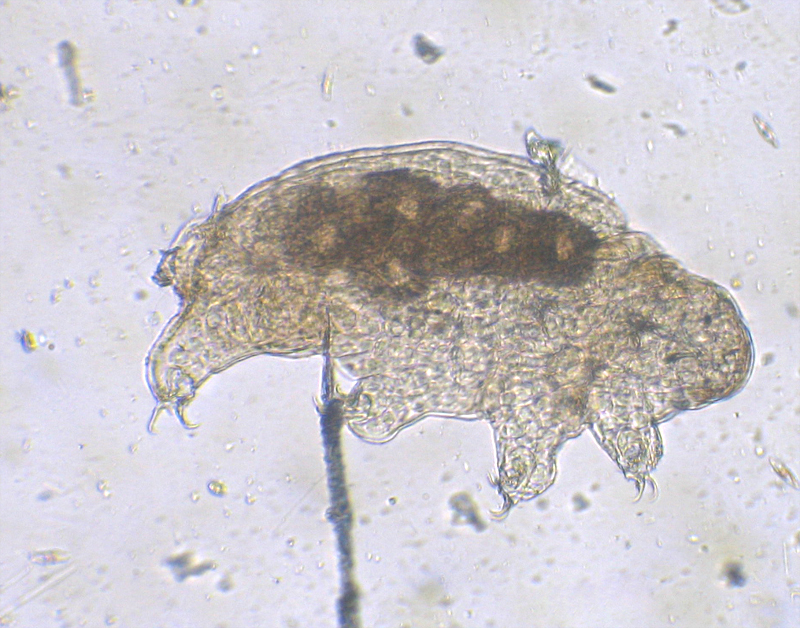Week 3: Tardigrada
Phylum: Tardigrada
Services and Dis-Services for Humans
By: Lila Boudrie, Kyle Douglass
This week in class I was presented an image of an unknown invert that I had to use to then discover its correct phylum. Luckily, my partner had a guess on what this organism was and we were able to make this discovery by looking in our text book. Below is an image of a tardigrade that shows good physical features and characteristics of the body. To give everyone a better understanding of other individuals included in this phylum click here for more images.
Environmental Pros:
One example of how tardigrades have been useful to humans in the last century is by aiding with conservation efforts. Lab samples of living organisms can quickly go bad and be of no use if they are not kept in necessary conditions. One of these factors is the temperature at which the specimens are kept. While traveling to and from labs, refrigeration is costly and not very sufficient for our energy usage. A company called Biomatrica has decided to use technology to mimic the survival strategy of many tardigrades. When they are running low on water, tardigrades will go into a “suspended state” where they can then survive anywhere from a couple of months to over 1o ten years. This process is a unique ability that tardigrades share that can increase their likelihood of surviving extreme environmental conditions. Ultimately this process allows for specimens to be held at room temperatures without going bad and without having to be refrigerated. One example of how this is beneficial for humans is because Stanford University researchers estimate that this can potentially replace 2,000 lab freezers with room temperature storage which will then reduce, over a ten year period the University’s carbon footprint by 18,000 metric tons. To give everyone another perspective- this is equivalent to 1.83 million gallons of gasoline. For more information about Biomatrica and their research please click here.
Environmental Cons:
What do you think?
Personally, I would argue that there are very little; if any at all negative contributions that these guys are making towards humans. One comment that really stuck out to me says,
“They are disappointingly small, (Cobb, 2015).”
Research Pros:
These unique inverts have been known for their ability to withstand extreme conditions such as freezing, boiling, environments, etc. Research has allowed scientists to discover so much more about not only the individuals themselves but other animals as well. Smithsonian.com goes on to say,
“Now scientists have discovered that tardigrades possess yet another extreme claim to fame: Their genome contains the most foreign DNA of any animal species known, (Nuwer, 2015).”
It has since been discovered that of their genetic make up, 1/6 comes from unrelated plants, fungi, and bacteria. Experiments and labs have been conducted only to prove that genes that seem to be foreign actually are coming from non animals. Scientists and researchers have concluded from this that about 17.5 percent of tardigrades genes are foreign material. This is only one example that shows researching these invert has been beneficial for humans. This information lead scientists further to hypothesize that this method of genetic development could also occur in animals.
Research Cons:
One way that Tardigrades are not as useful as we would like them to be is because of their unique qualities and abilities that we cannot relate to ourselves. We can research them and find out more about them, however that is also one of the dis-services these guys present to humans.
Comparing to the Phylum:
Tardigrades are all very similar and have about the same genetic makeup as well as body structure. So with that being said, there is not really anything to contrast with the phylum, however I did find another phylum that scientists and researchers are comparing to the Phylum Tardigrada. This is the Phylum Rotifera which is also an aquatic microscopic animal. These inverts are the next closest to tardigrades when it comes to containing foreign genes. Rotifers contain about 8-9 percent of foreign genes which is why scientists are leading to believe that the two phylums heavy dosage of foreign genes plays a role in their ability to withstand the extreme environmental conditions they are exposed to.
My Question:
I am curious if there is anyway that Tardigrades could negatively impact humans based on their unique and diverse genetic makeup. Research shows that there could be a possibility that other animals could also have similarities in their genetic makeup like those of Tardigrades. This makes me wonder if this could negatively impact us. I think that with all of their abilities to withstand extreme environments, this may be something that could affect humans in a negative way. Especially if research does show that this ability could be possible for other organisms then I think this could be something to carefully consider. This gives these Tardigrades and maybe others an advantage for survival that humans do not have.
Works Cited:
1. http://www.fieldguide1966.com/incredible-animals/category/tardigrada
2. https://en.wikipedia.org/wiki/Tardigrade
3. http://www.smithsonianmag.com/science-nature/water-bears-tardigrades-master-dna-thieves-animal-world-180957371/
4. http://animaldiversity.org/accounts/Tardigrada/
5. https://whyevolutionistrue.wordpress.com/2015/11/27/the-weird-genome-of-water-bears-tardigrades-more-than-a-sixth-of-it-was-swiped-from-distantly-related-species/


